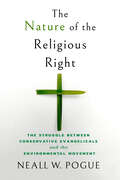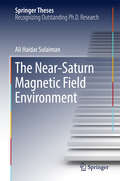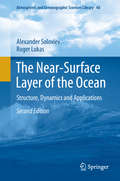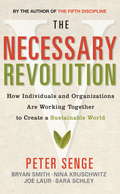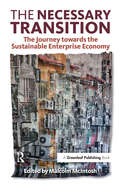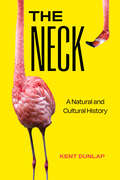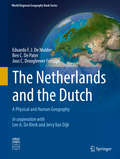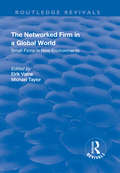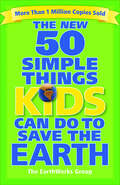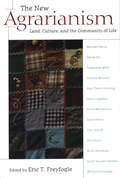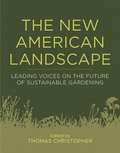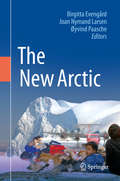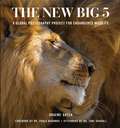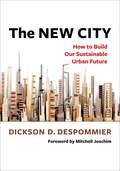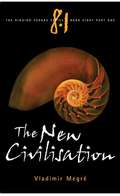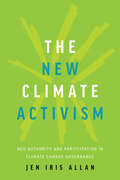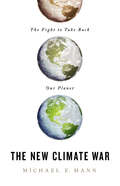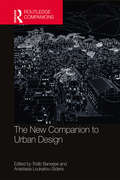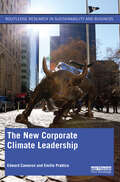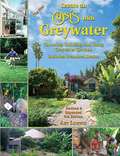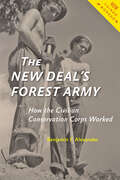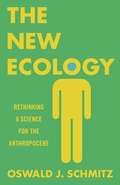- Table View
- List View
The Nature of the Religious Right: The Struggle between Conservative Evangelicals and the Environmental Movement
by Neall W. PogueIn The Nature of the Religious Right, Neall W. Pogue examines how white conservative evangelical Christians became a political force known for hostility toward environmental legislation. Before the 1990s, this group used ideas of nature to help construct the religious right movement while developing theologically based, eco-friendly philosophies that can be described as Christian environmental stewardship. On the twentieth anniversary of Earth Day in 1990, members of this conservative evangelical community tried to turn their eco-friendly philosophies into action. Yet this attempt was overwhelmed by a growing number in the leadership who made anti-environmentalism the accepted position through public ridicule, conspiracy theories, and cherry-picked science.Through analysis of rhetoric, political expediency, and theological imperatives, The Nature of the Religious Right explains how ideas of nature played a role in constructing the conservative evangelical political movement, why Christian environmental stewardship was supported by members of the community for so long, and why they turned against it so decidedly beginning in the 1990s.
The Near-Saturn Magnetic Field Environment
by Ali Haidar SulaimanThis thesis focuses on the very high Mach number shock wave that is located sunward of Saturn's strong magnetic field in the continuous high-speed flow of charged particles from the Sun (the solar wind). The author exploits the fact that the Cassini spacecraft is the only orbiter in a unique parameter regime, far different from the more familiar near-Earth space, to provide in-situ insights into the unreachable exotic regime of supernova remnants. This thesis bridges the gap between shock physics in the Solar System and the physics of ultra-high Mach number shocks around the remnants of supernova explosions, since to date research into the latter has been restricted to theory, remote observations, and simulations.
The Near-Surface Layer of the Ocean
by Alexander Soloviev Roger LukasThe rationale for publishing a second edition of this monograph is that this area of research continues to show remarkable advancement. The new generation of synthetic aperture radar satellites has provided unprecedented spatial resolution of sea surface features. In addition, satellites to measure sea surface salinity have been launched. Computational fluid dynamics models open new opportunities in understanding the processes in the near-surface layer of the ocean and their visibility from space. Passive acoustic methods for monitoring short surface waves have significantly progressed. Of importance for climate research, processes in the near-surface layer of the ocean contribute to errors in satellite estimates of sea surface temperature trends. Due to growing applications of near-surface science, it is anticipated that more students will be trained in this area of research. Therefore this second edition of the monograph is closer to a textbook format.
The Nebraska Winter of 1948-49: Stories of Survival (Disaster)
by Barry SeegebarthIn 1948-49, Nebraska experienced a winter like never before. Brutal cold, unbearable winds and record snowfall made roads impassable and life difficult for locals. Farmers and ranchers struggled with hunger due to a dwindling supply of coal and food. The governor requested federal aid, and the U.S. Air Force dropped bales of hay into pastures for animals. Many locals perished in the weather, and icy roads forced the state to redesign and rebuild highways. Author Barry Seegebarth details the tragedy and courage of the Nebraska winter of 1948.
The Necessary Revolution: How Individuals and Organizations are Working Together to Create a Sustainable World
by Bryan Smith Peter M. Senge Nina Kruschwitz Joe Laur Sara SchleyThe Necessary Revolution is a book about the end of The Industrial Age Bubble the take, make, waste way of thinking that has dominated the developed world for the past 200 years. It is also a book about a new era emerging in which companies are beginning to recognise the larger systems in which they operate (environmental, social, and economic) and integrate these into their core strategies. Imagine a world in which the excess energy from one business would be used to heat another. A world in which environmentally sound products and processes would be more cost effective than wasteful ones. A world in which corporations like BP, Nike, Coca-Cola, and countless others are forming partnerships with environmental and social justice NGOs to ensure better stewardship of the earth and better livelihoods in the developing world. Now, stop imagining that world is already emerging. We must act together now.
The Necessary Transition: The Journey towards the Sustainable Enterprise Economy
by Malcolm McIntoshLife on Earth for humanity and our ecosystems is at a point of great change. There is much to be learnt about previous great disruptions. The key words are *adaptation* and *transformation*. Most international companies operate across multiple social and environmental geographies, so they know this intellectual and practical landscape. And for many governments the challenges of social and environmental justice are also paramount – not least because equitable societies are best for business, and best for human well-being.The Necessary Transition addresses the many transitions taking place around the world: from high- to low-carbon economies, from gross inequality to egalitarianism, from massive human rights abuses to socially just societies, and from high corruption to societies with high social cohesion and integrity.The book brings together leading international researchers and practitioners to share their knowledge and expertise, and offers answers to many of the pressing questions that must be addressed in the journey towards a sustainable enterprise economy – an absolutely necessary transition for humanity.Contributors include: Sara Parkin, Founder-Director and Trustee of the UK's Forum for the Future; Bill Champion, Managing Director, Rio Tinto Coal Australia; and Mark Swilling, co-author of "Just Transitions" and Academic Director of the Sustainability Institute, South Africa.The key question is: "Is a transition to a sustainable future possible within the logic of conventional capitalism and 20th-century models of development?" This book provides radical perspectives from varying entry points and is essential reading for academics and practitioners interested in how we plan, speed and scale such necessary transitions.
The Neck: A Natural and Cultural History
by Kent DunlapA 300-million-year tour of the prominent role of the neck in animal evolution and human culture. Humans give a lot of attention to the neck. We decorate it with jewelry and ties, kiss it passionately, and use it to express ourselves in word and song. Yet, at the neck, people have also shackled their prisoners, executed their opponents, and slain their victims. Beyond the drama of human culture, animals have evolved their necks into a staggering variety of shapes and uses vital to their lifestyles. The Neck delves into evolutionary time to solve a living paradox—why is our neck so central to our survival and culture, but so vulnerable to injury and disease? Biologist Kent Dunlap shows how the neck's vulnerability is not simply an unfortunate quirk of evolution. Its weaknesses are intimately connected to the vessels, pipes, and glands that make it so vital to existence. Fun and far-reaching, The Neck explores the diversity of forms and functions of the neck in humans and other animals and shows how this small anatomical transition zone has been a locus of incredible evolutionary and cultural creativity.
The Netherlands and the Dutch: A Physical and Human Geography (World Regional Geography Book Series)
by Eduardo F. De Mulder Ben C. De Pater Joos C. Droogleever Fortuijn Len A. De Klerk Jerry Van DijkThis book presents a geographical survey of the Netherlands, reviewing recent and historic developments that made the nation. It is a relatively wealthy country and the Dutch belong to the happiest and healthiest on earth. But these qualities are not evenly spread over the country. The urban agglomeration of Randstad Holland in the west hosts most of the nation’s capital and young, well-educated people whereas older and less-educated people are concentrated in the peripheral areas in the north, east and south. Interactions between physical and human geographical aspects of the Netherlands are described quite extensively. Its position on one of Europe’s most prominent deltas, its abundance of energy resources and the course of history have all contributed to its present national position and international networks. But early and recent Dutch have also shaped this country. They reclaimed lakes and shallow seas, protected the lowlands against floods, re-allotted land parcels and designed and developed urban areas. Besides its focus on water-related topics, the book also covers social and cultural aspects. The book also discusses future challenges and offers scenarios for solutions. This is a book for those interested in a wide variety of recent aspects of the geography of the Netherlands described in a historical context. It appeals to students and researchers of many disciplines in geography, urban and landscape planning, water management, history and cultural studies.
The Networked Firm in a Global World: Small Firms in New Environments (Routledge Revivals)
by Michael Taylor Eirik VatneThis title was first published in 2000. Illustrated by a wide range of international case studies, this volume elaborates, extends and critiques one of the key models of local growth, which emphasizes learning, networking and 'embeddedness' in relation to the role of small and medium-sized firms (SMEs). In doing so, it provides a comprehensive understanding of the changing role of SMEs in an era of globalization.
The New 50 Simple Things Kids Can Do to Save the Earth
by Sophie Javna EarthWorks GroupIn The New 50 Simple Things Kids Can Do to Save the Earth, Sophie and John have revised the original best-selling book for a concerned and vibrant Web 2.0 youth market. It's easy-to-do and kid-friendly projects show that kids can make a difference, and each chapter is packed with tons of links to groups and resources. What makes this book stand out, though, is that it doesn't just inform kids, it encourages them to make a difference by providing them, their friends and their families the tools to take action.Together, John and Sophie enlighten, educate, and encourage our children with easy and smart ways to save the earth. Pretty darn cool, huh? We thought so. What you can do: Order now and help save the only earth we've got.Mother Earth needs our help now.
The New Agrarianism: Land, Culture, and the Community of Life
by Eric T. FreyfogleThe engaging writings gathered in this new book explore an important but little-publicized movement in American culture -- the marked resurgence of agrarian practices and values in rural areas, suburbs, and even cities. It is a movement that in widely varied ways is attempting to strengthen society's roots in the land while bringing greater health to families, neighborhoods, and communities. The New Agrarianism vividly displays the movement's breadth and vigor, with selections by such award-winning writers as Wendell Berry, William Kittredge, Stephanie Mills, David Orr, Scott Russell Sanders, and Donald Worster. As editor Eric Freyfogle observes in his introduction, agrarianism is properly conceived in broad terms, as reaching beyond food production to include a wide constellation of ideals, loyalties, sentiments, and hopes. It is a temperament and a moral orientation as well as a suite of diverse economic practices -- all based on the insistent truth that people everywhere are part of the land community, as dependent as other life on its fertility and just as shaped by its mysteries and possibilities. The writings included here have been chosen for their engaging narratives as well as their depiction of the New Agrarianism's broad scope. Many of the selections illustrate agrarian practitioners in action, while other selections offer pointed critiques of contemporary American culture and its market-driven, resource-depleting competitiveness. Together, they reveal what Freyfogle identifies as the heart and soul of the New Agrarianism: its yearning to regain society's connections to the land and its quest to help craft a more land-based and enduring set of shared values. The New Agrarianism offers a compelling vision of this hopeful new way of living. It is an essential book for social critics, community activists, organic gardeners, conservationists, and all those seeking to forge sustaining ties with the entire community of life.
The New American Landscape: Leading Voices on the Future of Sustainable Gardening
by Thomas ChristopherGardeners are the front line of defense in our struggle to tackle the problems of global warming, loss of habitat, water shortages, and shrinking biodiversity. In The New American Landscape, author and editor Thomas Christopher brings together the best thinkers on the topic of gardening sustainably, and asks them to describe the future of the sustainable landscape. The discussion unfolds from there, and what results is a collective vision as eloquent as it is diverse.The New American Landscape offers designers a roadmap to a beautiful garden that improves, not degrades the environment. It’s a provocative manifesto about the important role gardens play in creating a more sustainable future that no professional garden designer can afford to miss. John Greenlee and Neil Diboll on the new American meadow gardenRick Darke on balancing natives and exotics in the gardenDoug Tallamy on landscapes that welcome wildlifeEric Toensmeier on the sustainable edible gardenDavid Wolfe on gardening sustainable with a changing climateElaine Ingham on managing soil healthDavid Deardorff and Kathryn Wadsworth on sustainable pest solutionsEd Snodgrass and Linda McIntyre on green roofs in the sustainable residential landscapeThomas Christopher on waterwise gardensToby Hemenway on whole system garden designThe Sustainable Site Initiative on the managing the home landscape as a sustainable site
The New Arctic
by Birgitta Evengård Joan Nymand Larsen Øyvind PaascheIn the late 18th century explorers and scientists started venturing into the Arctic in a heroic and sometimes deadly effort to understand and unveil the secrets of the unforgiving and mysterious polar region of the high north. Despite that the Arctic was already populated mattered less for the first wave of polar researchers and explorations who nevertheless, brought back valuable knowledge. Today the focus in Arctic science and discourse has changed to one which includes the peoples and societies, and their interaction with the world beyond. The image of a static Arctic - heralded first by explorers - prevailed for a long time, but today the eyes of the World see the Arctic very differently. Few, if any, other places on Earth are currently experiencing the kind of dramatic change witnessed in the Arctic. According to model forecasts, these changes are likely to have profound implications on biophysical and human systems, and will accelerate in the decades to come. "The New Arctic" highlights how, and in what parts, the natural and political system is being transformed. We're talking about a region where demography, culture, and political and economic systems are increasingly diverse, although many common interests and aspects remain; and with the new Arctic now firmly placed in a global context. Settlements range from small, predominantly indigenous communities, to large industrial cities, and all have a link to the surrounding environment, be it glaciers or vegetation or the ocean itself. "The New Arctic" contributes to our further understanding of the changing Arctic. It offers a range of perspectives, which reflect the deep insight of a variety of scientific scholars across many disciplines bringing a wide range of expertise. The book speaks to a broad audience, including policy-makers, students and scientific colleagues.
The New Big 5
by Graeme GreeneThe world&’s wildlife is in crisis, and the next ten years are critical.The New Big 5 brings together more than 145 of the world&’s greatest wildlife photographers, conservationists, and advocates in a mission to not only celebrate the natural beauty of the animal world, but to raise awareness of the crucial issues facing these magnificent creatures. Until recently, the Big Five referred to the five big-game animals that were most difficult for colonial hunters to shoot and kill. Wildlife photographer Graeme Green&’s The New Big 5 Project set about to reclaim that gruesome, antiquated term by asking people around the world to vote on the five endangered animals they would most want to shoot—with a camera. More than fifty thousand people voted, and the New Big 5 list of Wildlife Photography was born. What are the New Big 5? Elephants Gorillas Tigers Lions Polar Bears With 226 stunning photos and informative essays from the world&’s greatest wildlife advocates, this one-of-a-kind book inspires and raises awareness about the New Big 5, and our wildlife world. FEATURES MANY OTHER ENDANGERED SPECIES: An extensive chapter is devoted to endangered species, such as rhinos, cheetahs, lemurs, frogs, vultures, sharks, whales, and turtles. INCREDIBLE CREATIVE PHOTOGRAPHY: Majestic portraits, animals in their habitat, and examples of natural behavior from more than 145 renowned wildlife photographers, including Ami Vitale, Marsel van Oosten, Paul Nicklen, Steve McCurry, Karine Aigner, Brian Skerry, Lucas Bustamante, Beverly Joubert, Clement Kiragu, Thomas Mangelsen, Paul Hilton, Suzi Eszterhas, Sascha Fonseca, Cristina Mittermeier, Frans Lanting, Marina Cano, Gael R. Vande Weghe, Daisy Gilardini, Steve Winter, Qiang Zhang, Art Wolfe, Dhritiman Mukherjee, Will Burrard-Lucas, David Lloyd, Vicki Jauron, Sergey Gorshkov, and Thomas Vijayan. ENGAGING ESSAYS from leading conservationists, including Dr. Jane Goodall, Dr. Paula Kahumbu (Wildlife Direct), Dr. Tara Stoinski (CEO, Dian Fossey Gorilla Fund), Krista Wright (Executive Director, Polar Bears International), Dr. Anish Andheria (CEO, Wildlife Conservation Trust), Dr. Moreangels Mbizah (Executive Director, Wildlife Conservation Action), Dominique Gonçalves (Manager, Elephant Ecology Project at Gorongosa National Park), and Wes Sechrest (CEO, Re:wild). &“I hope the photos in this The New Big 5 book will lead people into the wonderful worlds of these iconic species - elephants, polar bears, gorillas, tigers and lions - and encourage them to explore the lives of so many other fascinating creatures, many of which are also endangered. Then, perhaps, other people will become involved in helping to create a world where wildlife can flourish for future generations to enjoy. I believe we have a window of time during which we can start to heal some of the harm we have inflicted on the natural world and slow down the heating of the planet. But only if we get together and take action now.&” - Dr. Jane Goodall
The New City: How to Build Our Sustainable Urban Future
by Dickson DespommierCities are at once among humanity’s crowning achievements and core drivers of the climate crisis. Their dependence on the outside world for vital resources is causing global temperatures to rise and wildlife habitats to shrink. But we have the opportunity to make cities more sustainable by transforming the built environment.Dickson D. Despommier proposes a visionary yet achievable plan for creating a new, self-sustaining urban landscape. He argues that we can find solutions through the concept of biomimicry: emulating successful strategies found in nature. A better city is possible if we heed the lessons that forests and trees teach about how to store carbon, grow food, collect rainwater, and convert sunlight into energy. Touring established and leading-edge technologies, The New City provides a blueprint for tomorrow’s urban environment. Cities built from wood will be more resilient and less destructive than concrete and steel construction; they will also encourage reforestation, boosting carbon sequestration. Vertical farms inside city limits will supply residents with a reliable, healthy food supply. Buildings will harvest moisture from the rain and air to secure a clean water supply. Renewable energy, including not only wind, solar, and geothermal but also clear photovoltaic window glass and nonpolluting hydrogen fuel cells, will power a cleaner city.The New City delivers both a passionate call to action for halting climate change and a bold vision of the sustainable future within our grasp.
The New Civilisation (The Ringing Cedars Series #8, Part #1)
by Vladimir Megré John Woodsworth Leonid Sharashkin"The New Civilisation" is Book 8 Part 1 of The Ringing Cedars Book Series. This series of nine books tells the story of a remarkable woman named Anastasia, discovered in 1995 by a Siberian trader, Vladimir Megré, while he was plying the waters of the remote Ob River. Anastasia was born in the forest in 1969 to parents who died tragically when she was just a baby. Living for the most part without warm clothes, food cultivation or man-made shelter, she has survived on fruit, nuts, berries and mushrooms, brought to her by "wild" animals with which she lives in peaceful harmony. Megré initially spent three days with Anastasia, during which time she displayed such astounding knowledge, power and wisdom that he abandoned his business and, at her request, began writing this series. She told him she would encode the books with an energy that would cause them to sell in the millions. Despite his lack of writing experience, this is exactly what happened. It is Anastasia's ability to strike a chord in the heart of the reader that makes these books so very unusual. The purity and power of her words is provoking an outpouring of joy and hope in people from all walks of life.
The New Climate Activism: NGO Authority and Participation in Climate Change Governance
by Jen AllanAt the 2019 UN climate change conference, activists and delegates for groups representing Indigenous, youth, women, and labour rights were among those marching through the halls chanting "Climate Justice, People Power." In The New Climate Activism, Jen Iris Allan looks at why and how these social activists came to participate in climate change governance while others, such as those working on human rights and health, remain on the outside of climate activism. Through case studies of women’s rights, labour, alter-globalization, health, and human rights activism, Allan shows that some activists sought and successfully gained recognition as part of climate change governance, while others remained marginalized. While concepts key to some social activists, including gender mainstreaming, just transition, and climate justice are common terms, human rights and health remain "fringe issues" in climate change governance. The New Climate Activism explores why and how these activists brought their issues to climate change, and why some succeeded while others did not.
The New Climate War: The Fight to Take Back Our Planet
by Michael E. MannA renowned climate scientist shows how fossil fuel companies have waged a thirty-year campaign to deflect blame and responsibility and delay action on climate change, and offers a battle plan for how we can save the planet. Recycle. Fly less. Eat less meat. These are some of the ways that we've been told can slow climate change. But the inordinate emphasis on individual behavior is the result of a marketing campaign that has succeeded in placing the responsibility for fixing climate change squarely on the shoulders of individuals.Fossil fuel companies have followed the example of other industries deflecting blame (think "guns don't kill people, people kill people") or greenwashing (think of the beverage industry's "Crying Indian" commercials of the 1970s). Meanwhile, they've blocked efforts to regulate or price carbon emissions, run PR campaigns aimed at discrediting viable alternatives, and have abdicated their responsibility in fixing the problem they've created. The result has been disastrous for our planet.In The New Climate War, Mann argues that all is not lost. He draws the battle lines between the people and the polluters-fossil fuel companies, right-wing plutocrats, and petrostates. And he outlines a plan for forcing our governments and corporations to wake up and make real change, including:a common-sense, attainable approach to carbon pricing- and a revision of the well-intentioned but flawed currently proposed version of the Green New Deal;allowing renewable energy to compete fairly against fossil fuelsdebunking the false narratives and arguments that have worked their way into the climate debate and driven a wedge between even those who support climate change solutionscombatting climate doomism and despair-mongering With immensely powerful vested interests aligned in defense of the fossil fuel status quo, the societal tipping point won't happen without the active participation of citizens everywhere aiding in the collective push forward. This book will reach, inform, and enable citizens everywhere to join this battle for our planet.
The New Community Rules: Marketing on the Social Web
by Tamar WeinbergBlogs, networking sites, and other examples of the social web provide businesses with a largely untapped marketing channel for products and services. But how do you take advantage of them? With The New Community Rules, you'll understand how social web technologies work, and learn the most practical and effective ways to reach people who frequent these sites. Written by an expert in social media and viral marketing, this book cuts through the hype and jargon to give you intelligent advice and strategies for positioning your business on the social web, with case studies that show how other companies have used this approach. The New Community Rules will help you:Explore blogging and microblogging, and find out how to use applications such as Twitter to create brand awarenessLearn the art of conversation marketing, and how social media thrives on honesty and transparencyManage and enhance your online reputation through the social webTap into the increasingly influential video and podcasting marketDiscover which tactics work -- and which don't -- by learning about what other marketers have triedMany consumers today use the Web as a voice. The New Community Rules demonstrates how you can join the conversation, contribute to the community, and bring people to your product or service.
The New Companion to Urban Design
by Tridib Banerjee Anastasia Loukaitou-SiderisThe New Companion to Urban Design continues the assemblage of rich and critical ideas about urban form and design that began with the Companion to Urban Design (Routledge, 2011). With chapters from a new set of contributors, this sequel offers a more comparative perspective representing multiple voices and perspectives from the Global South. The essays in this volume are organized in three parts: Part I: Comparative Urbanism; Part II: Challenges; and Part III: Opportunities. Each part contains distinct sections designed to address specific themes, and includes a list of annotated suggested further readings at the end of each chapter. Part I: Comparative Urbanism examines different variants of urbanism in the Global North and the Global South, produced by a new economic order characterized by the mobility of labor, capital, information, and technology. Part II: Challenges discusses some of the contemporary challenges that cities of the Global North and the Global South are facing and the possible role of urban design. This part discusses spatial claims and conflicts, challenges generated by urban informality, explosive growth or dramatic shrinkage of the urban settlement, gentrification and displacement, and mimesis, simulacra and lack of authenticity. Part III: Aspirations discusses some normative goals that urban design interventions aspire to bring about in cities of the Global North and the Global South. These include resilience and sustainability, health, conservation/restoration, justice, intelligence, access and mobility, and arts and culture. The New Companion to Urban Design is primarily intended for scholars and graduate students interested in cities and their built environment. It offers an invaluable and up-to-date guide to current thinking across a range of disciplines including urban design, planning, urban studies, and geography.
The New Corporate Climate Leadership (Routledge Research in Sustainability and Business)
by Edward Cameron Emilie PratticoThis book provides a comprehensive treatment of the role of the private sector in accelerating the transition to a low-carbon, climate-resilient, and inclusive world. In the lead up to and since the historic Paris Agreement on climate change, more than 6,000 companies from 120 countries representing more than $36.5 trillion in revenue have made climate commitments. Examining this trend, The New Corporate Climate Leadership provides a clear synthesis of the relationship between the real economy and climate change and offers a state-of-the-art assessment of corporate initiatives that focus on greenhouse gas emissions reductions and the management of climate risk through enhanced resilience. It debates the relative merits of incremental and sequenced ambition versus radical systems change – including a critique of the prevailing capitalist approach to climate change – and provides an actionable guide to skills development for change-makers in the shift toward a low-carbon world. Drawing on perspectives from leading thinkers inside the private sector, across government, and within civil society to truly interrogate the scale, scope, and speed of progress, this book provides a clear vision for what the next generation of corporate climate leadership should look like. Optimistic in tone, this book will be of great interest to students, scholars, and practitioners of climate change and sustainable business.
The New Create an Oasis With Greywater:Choosing, Building, and Using Greywater Systems (5th Edition)
by Art LudwigThis book describes how to choose, build, and use 20 types of residential greywater reuse systems in just about any context: urban, rural, or village.
The New Deal's Forest Army: How the Civilian Conservation Corps Worked (How Things Worked)
by Benjamin F. AlexanderHow the Civilian Conservation Corps constructed, rejuvenated, and protected American forests and parks at the height of the Great Depression.Propelled by the unprecedented poverty of the Great Depression, President Franklin D. Roosevelt established an array of massive public works programs designed to provide direct relief to America’s poor and unemployed. The New Deal’s most tangible legacy may be the Civilian Conservation Corps’s network of parks, national forests, scenic roadways, and picnic shelters that still mark the country’s landscape. CCC enrollees, most of them unmarried young men, lived in camps run by the Army and worked hard for wages (most of which they had to send home to their families) to preserve America’s natural treasures. In The New Deal’s Forest Army, Benjamin F. Alexander chronicles how the corps came about, the process applicants went through to get in, and what jobs they actually did. He also explains how the camps and the work sites were run, how enrollees spent their leisure time, and how World War II brought the CCC to its end. Connecting the story of the CCC with the Roosevelt administration’s larger initiatives, Alexander describes how FDR’s policies constituted a mixed blessing for African Americans who, even while singled out for harsh treatment, benefited enough from the New Deal to become an increasingly strong part of the electorate behind the Democratic Party. The CCC was the only large-scale employment program whose existence FDR foreshadowed in speeches during the 1932 campaign—and the dearest to his heart throughout the decade that it lasted. Alexander reveals how the work itself left a lasting imprint on the country’s terrain as the enrollees planted trees, fought forest fires, landscaped public parks, restored historic battlegrounds, and constructed dams and terraces to prevent floods. A uniquely detailed exploration of life in the CCC, The New Deal’s Forest Army compellingly demonstrates how one New Deal program changed America and gave birth to both contemporary forestry and the modern environmental movement.
The New Ecology: Rethinking a Science for the Anthropocene
by Oswald J. SchmitzHow the science of ecology is changing to meet the daunting challenges of environmental sustainabilityOur species has transitioned from being one among millions on Earth to the species that is single-handedly transforming the entire planet to suit its own needs. In order to meet the daunting challenges of environmental sustainability in this epoch of human domination—known as the Anthropocene—ecologists have begun to think differently about the interdependencies between humans and the natural world. This concise and accessible book provides the best available introduction to what this new ecology is all about—and why it matters more than ever before.Oswald Schmitz describes how the science of ecology is evolving to provide a better understanding of how human agency is shaping the natural world, often in never-before-seen ways. The new ecology emphasizes the importance of conserving species diversity, because it can offer a portfolio of options to keep our ecosystems resilient in the face of environmental change. It envisions humans taking on new roles as thoughtful stewards of the environment to ensure that ecosystems have the enduring capacity to supply the environmental services on which our economic well-being—and our very existence—depend. It offers the ecological know-how to maintain and enhance our planet's environmental performance and ecosystem production for the benefit of current and future generations.Informative and engaging, The New Ecology shows how today’s ecology can provide the insights we need to appreciate the crucial role we play in this era of unprecedented global environmental transition.
The New Economy of Nature
by Gretchen C. Daily Catherine EllisonHow to use the environment profitably.
